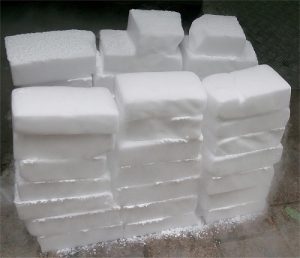Phase Changes
Matter exists as one of three phases: solid, liquid, or gas. The phase of a substance depends on its thermal energy and temperature. Substances exist in the gas phase at higher temperatures and in the solid phase at lower temperature. The liquid phase occurs between these temperatures.
As defined in an earlier chapter, a phase change is a physical process in which a substance goes from one phase to another. Usually the change occurs when adding or removing heat at a particular temperature, known as the melting point or the boiling point of the substance. The melting point is the temperature at which the substance goes from a solid to a liquid (or from a liquid to a solid). The boiling point is the temperature at which a substance goes from a liquid to a gas (or from a gas to a liquid). The nature of the phase change depends on the direction of the heat transfer. Heat going into a substance changes it from a solid to a liquid or a liquid to a gas. Removing heat from a substance changes a gas to a liquid or a liquid to a solid.
Two key points are worth emphasizing. First, at a substance’s melting point or boiling point, two phases can exist simultaneously. Take water as an example. On the Celsius scale, water has a melting point of 0 °C and a boiling point of 100 °C. At 0 °C, both the solid and liquid phases of water can coexist. However, if heat is added, some of the solid ice will melt and turn into liquid water. If heat is removed, the opposite happens: some of the liquid water turns into solid ice. A similar process can occur at 100 °C: adding heat increases the amount of gaseous steam, while removing heat increases the amount of liquid water.
Second, the temperature of a substance does not change as the substance goes from one phase to another. In other words, phase changes are isothermal (isothermal means “constant temperature”). Again, consider water as an example. Solid water (ice) can exist at 0 °C. If heat is added to ice at 0 °C, some of the solid changes phase to make liquid, which is also at 0 °C. Remember, the solid and liquid phases of water can coexist at 0 °C. Only after all of the solid has melted into liquid does the addition of heat change the temperature of the substance.
Remember that a phase change depends on the direction of the heat transfer. If heat transfers in, solids become liquids, and liquids become solids at the melting and boiling points, respectively. If heat transfers out, liquids solidify, and gases condense into liquids.
Phase changes can also be classified as exothermic or endothermic. For example, evaporation is an endothermic process. During evaporation, heat transfers into a substance, changing it from liquid to gas. Thus, the substance absorbs heat and the change is endothermic. For example, when the water on your skin evaporates, it absorbs heat from your skin and causes you to feel cold. The cooling effect can be evident when you leave a swimming pool or a shower. Similarly, the evaporation of sweat is an important endothermic process that cools us in hot weather and helps us regulate our body temperature. In very hot climates, we can lose as much as 1.5 L of sweat per day.

Example: Identifying Exothermic vs. Endothermic Phase Changes
Identify the following phase changes as exothermic or endothermic:
- Liquid water evaporates and forms gaseous steam
- Water vapor condenses to form liquid water droplets on a cold surface
- Solid chocolate melts to form liquid chocolate for a chocolate fountain
- A mixture of liquid ice cream freezes to form solid ice cream
Solution
- The gas phase has higher thermal energy and higher temperature than the liquid phase. The water must absorb heat to be converted from liquid to a gas (evaporation), thus, this process is endothermic.
- The liquid phase has lower thermal energy and lower temperature than the gas phase. The water must release heat to be converted from a gas to a liquid (condensation), thus, this process is exothermic.
- The liquid phase has higher thermal energy and higher temperature than the solid phase. The chocolate must absorb heat to be converted from a solid to a liquid (melting), thus, this process is endothermic.
- The solid phase has lower thermal energy and lower temperature than the liquid phase. The ice cream must release heat to be converted from a liquid to a solid (freezing), thus, this process is exothermic.
Looking Closer: Sublimation
There is also a phase change where a solid goes directly to a gas:
solid → gas
This phase change is called sublimation. We encounter sublimation in several ways. You may already be familiar with dry ice, which is simply solid carbon dioxide. At −78.5°C (−109°F), solid carbon dioxide sublimes, changing directly from the solid phase to the gas phase. Solid carbon dioxide is called dry ice because it does not pass through the liquid phase. Instead, it goes directly to the gas phase. (Carbon dioxide can exist as liquid but only under high pressure.) Dry ice has many practical uses, including the long-term preservation of medical samples.

Even at temperatures below 0°C, solid water (ice) will slowly sublime. For example, a thin layer of snow or frost on the ground may slowly disappear as the solid ice sublimes, even though the outside temperature may be below the freezing point of water. Similarly, ice cubes in a freezer may get smaller over time. Although frozen, the solid ice slowly sublimes, redepositing on the colder cooling elements of the freezer, which necessitates periodic defrosting. (Frost-free freezers minimize this redeposition.) Lowering the temperature in a freezer will reduce the need to defrost as often.
Under similar circumstances, water will also sublime from frozen foods (e.g., meats or vegetables), giving them an unattractive, mottled appearance called freezer burn. It is not really a “burn,” and the food has not necessarily gone bad, although it looks unappetizing. Freezer burn can be minimized by lowering a freezer’s temperature and by wrapping foods tightly so water does not have any space to sublime into.
Attributions
This page is based on “Chemistry 2e” by Paul Flowers, Klaus Theopold, Richard Langley, William R. Robinson, PhD, Openstax which is licensed under CC BY 4.0. Access for free at https://openstax.org/books/chemistry-2e/pages/1-introduction
This page is based on “The Basics of General, Organic, and Biological Chemistry” by David W Ball, John W Hill, Rhonda J Scott, Saylor which is licensed under CC BY-NC-SA 4.0. Access for free at http://saylordotorg.github.io/text_the-basics-of-general-organic-and-biological-chemistry/index.html

